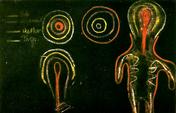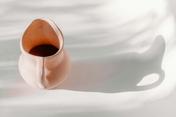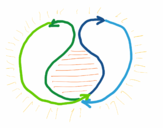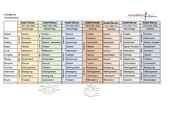What you will learn in this course
German text below / Deutscher Text unten
This eurythmy therapy course provides eurythmy therapists, doctors, and students with valuable insights into the application and effects of specific sound gestures, as well as the corresponding leg movements and jumps. Eurythmists and people with a general interest in eurythmy are also cordially invited.
Through a combination of demonstrations, personal practice, and discussions on experiences gathered throughout the week, participants will explore the therapeutic aspects of eurythmy in all their richness.
What do eurythmy therapists learn in this course? (Examples)
- The gentle W-movements of the legs and arms: How these movements help individuals reconnect deeply with their bodies, promoting flexibility, fluidity, and a sense of renewal.
- The R-movement for weight issues and sluggish digestion: How R can help lighten stagnation and, in children, clear blocked nasal passages.
- Leg movements and jumps with H: We will discuss how they vary depending on whether the stomach is tense, whether more inner form-building strength is needed for obesity, or whether young children resist toilet training and prefer nappies.
- The protective, enveloping quality of B: How B can be used to treat incontinence in elderly patients and which leg movements support this process.
- Structuring the will through P: How this movement strengthens body awareness, why P is used for treating incontinence in children, and how the corresponding leg movements are applied.
What do doctors learn in this course?
- The relationship between movement and physiological processes: For example, how B and P regulate warmth and the sense of self, or how R and D support individuals who struggle to generate internal warmth for digestion.
- Indications for various eurythmy therapy exercises: Which consonants are particularly effective for incontinence, digestive disorders, heart conditions, or addiction?
- Integrating eurythmy therapy into medical practice: How doctors can introduce their patients to eurythmy therapy and establish a productive collaboration with eurythmy therapists.
Why is this course also suitable for eurythmists and eurythmy students?
- This course offers an in-depth exploration of leg movements and jumps, expanding participants' practical repertoire.
- The techniques taught enhance body awareness, can support pedagogical processes, and enrich artistic expression.
- The interdisciplinary exchange opens new perspectives: eurythmists benefit from practical case studies and creative approaches from eurythmy therapy.
- Since both theoretical and practical aspects are covered, the course provides an excellent foundation for future professional training in this field.
Why is the course also open to those with little experience in eurythmy?
- Practical exercises and clear explanations make the course accessible to beginners.
- Participants experience how specific movements enhance body awareness and directly influence etheric qualities, organs, and areas in need of support.
- Even without prior knowledge, participants develop a deep understanding of the therapeutic potential and application of eurythmy.
Conclusion
This course provides not only theoretical knowledge but also a profound experience of the transformative forces of eurythmy therapy. We will develop concrete tools and support one another in using eurythmy therapy to promote health and inner balance.
For eurythmy therapists, the course offers an opportunity to deepen their skills; for doctors, an introduction to the therapeutic effects of eurythmic movement; and for eurythmists, a way to expand their professional perspective.
General participants will gain a fundamental introduction to the potential of eurythmy therapy – an aspect of eurythmy that is rarely covered in public courses.
Deutsch
Dieser Heileurythmiekurs vermittelt Heileurythmist:innen, Ärzt:innen und Studierenden wertvolle Einblicke in die Anwendung und Wirkung spezifischer Lautgebärden sowie der dazugehörigen Beinbewegungen und Sprünge. Auch Eurythmist:innen und Menschen mit allgemeinem Interesse an Eurythmie sind herzlich eingeladen.
Durch die Kombination von Demonstrationen, eigenem Erproben und dem Austausch über die während der Woche gesammelten Erfahrungen erleben die Teilnehmenden die therapeutischen Aspekte der Eurythmie in ihrer ganzen Vielfalt.
Was lernen Heileurythmist:innen in diesem Kurs? (Beispiele)
- Die sanften W-Bewegungen der Beine und Arme. Sie bringen den Menschen auf eine tiefe Art und Weise wieder mit seinem Leib in Verbindung, lassen ihn wieder weich und beweglich werden und bringen in Fluss, führen in die Zukunft.
- Dar R bei bei Übergewicht und schwerfälliger Verdauung: Das R kann helfen, das Gewordene wieder ins Leichte zu bringen. Oder bei Kindern verstopfte Nasen wieder frei machen.
- Die Beinbewegungen und Sprünge beim H. Sie werden ganz verschieden gestaltet, je nachdem, ob der Magen verkrampft ist, ob es bei Adipositas wieder mehr innere Formkraft braucht, oder wenn Klein-Kinder nicht auf die Toilette gehen wollen und lieber weiter in die Windeln machen wollen…
- Die schützende, einhüllende Qualität des B, warum mit B Inkontinenz bei alten Menschen behandelt werden kann und mit welchen Beinbewegungen.
- Die Ordnung der Willensstruktur durch das P, welche durch die Bewegung in das Körpergefühl hereingeholt wird, warum Inkontinenz bei Kindern mit P behandelt wird, und wie die Beinbewegungen dafür gestaltet werden.
Was lernen Ärzt:innen in diesem Kurs?
- Zusammenhänge zwischen Bewegung und physiologischen Prozessen: Wie zum Beispiel B und P das Verhältnis zur Wärme und zum Ich regulieren oder wie R und D Menschen mit kalter Verdauung helfen.
- Indikationen für verschiedene Heileurythmie-Übungen: Welche Konsonanten sind zum Beispiel bei Inkontinenz, Verdauungsstörungen, Herzproblemen oder Suchtverhalten besonders wirksam?
- Integration der Heileurythmie in die medizinische Praxis: Wie Ärzt:innen ihre Patient:innen für Heileurythmie sensibilisieren und eine fruchtbare Zusammenarbeit mit Heileurythmist:innen gestalten können.
Warum richtet sich der Kurs auch an Eurythmist:innen und Eurythmiestudent:innen?
- Dieser Kurs ermöglicht eine gezielte Vertiefung der Beinbewegungen und Sprünge und erweitert so das praktische Repertoire der Teilnehmenden.
- Die vermittelten Techniken fördern das Körperbewusstsein, unterstützen therapeutische und pädagogische Prozesse und bereichern das künstlerische Ausdrucksspektrum.
- Der interdisziplinäre Austausch eröffnet neue Perspektiven: Eurythmist:innen profitieren von praxisnahen Fallbeispielen und kreativen Ansätzen aus der Heileurythmie.
- Da sowohl theoretische als auch praktische Aspekte behandelt werden, bietet der Kurs eine ideale Vorbereitung für eine zukünftige Tätigkeit in diesem spannenden Feld.
Warum ist der Kurs auch für Menschen offen, die wenig Erfahrung mit Eurythmie haben?
- Die praxisnahen Übungen und verständlichen Grundlagen machen den Kurs auch für Einsteiger:innen zugänglich.
- Sie erleben, wie gezielte Bewegungen das Körperbewusstsein stärken und positiv auf ätherische Qualitäten, Organe und bedürftige Körperbereiche wirken.
- Auch ohne Vorkenntnisse erhalten die Teilnehmenden ein tiefes Verständnis für das therapeutische Potenzial der Eurythmie.
Fazit
Dieser Kurs vermittelt nicht nur Wissen, sondern auch eine tiefgehende Erfahrung mit den Kräften der Heileurythmie. Wir erarbeiten konkrete Werkzeuge und unterstützen uns gegenseitig, um Menschen in ihrer Gesundheit und ihrem seelischen Gleichgewicht zu begleiten.
Für Heileurythmist:innen ist der Kurs eine wertvolle Möglichkeit zur Vertiefung ihrer Kenntnisse, für Ärzt:innen eine Einführung in die therapeutische Wirkung der Heileurythmie und für Eurythmist:innen eine Bereicherung ihrer Praxis.
Allgemein Interessierte erhalten eine grundlegende Einführung in die Potenziale der Heileurythmie – eine Seite der Eurythmie, die in öffentlichen Kursen selten vermittelt wird.


























































